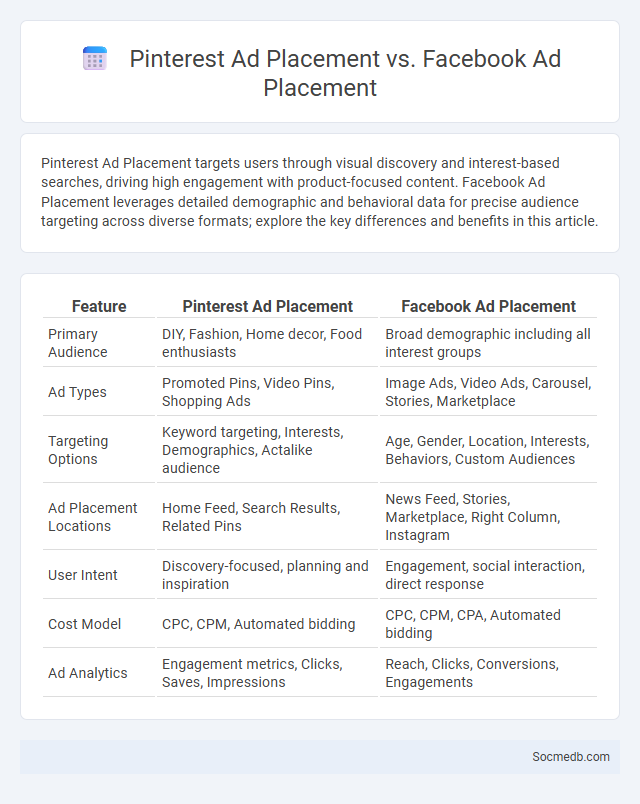
Photo illustration: Pinterest Ad Placement vs Facebook Ad Placement
Pinterest Ad Placement targets users through visual discovery and interest-based searches, driving high engagement with product-focused content. Facebook Ad Placement leverages detailed demographic and behavioral data for precise audience targeting across diverse formats; explore the key differences and benefits in this article.
Table of Comparison
| Feature | Pinterest Ad Placement | Facebook Ad Placement |
|---|---|---|
| Primary Audience | DIY, Fashion, Home decor, Food enthusiasts | Broad demographic including all interest groups |
| Ad Types | Promoted Pins, Video Pins, Shopping Ads | Image Ads, Video Ads, Carousel, Stories, Marketplace |
| Targeting Options | Keyword targeting, Interests, Demographics, Actalike audience | Age, Gender, Location, Interests, Behaviors, Custom Audiences |
| Ad Placement Locations | Home Feed, Search Results, Related Pins | News Feed, Stories, Marketplace, Right Column, Instagram |
| User Intent | Discovery-focused, planning and inspiration | Engagement, social interaction, direct response |
| Cost Model | CPC, CPM, Automated bidding | CPC, CPM, CPA, Automated bidding |
| Ad Analytics | Engagement metrics, Clicks, Saves, Impressions | Reach, Clicks, Conversions, Engagements |
Introduction to Social Media Ad Placements
Social media ad placements refer to the specific locations where advertisements appear across various platforms such as Facebook, Instagram, Twitter, and LinkedIn. These placements include feeds, stories, sidebars, in-stream videos, and search results, each optimized for user engagement and targeting precision. Understanding platform-specific ad formats and placement options enables marketers to maximize reach, improve click-through rates, and enhance return on investment (ROI).
Overview of Pinterest Ad Placement
Pinterest ad placement offers multiple formats including Promoted Pins, Video Pins, and Shopping Ads that seamlessly integrate into users' feeds for high engagement. Targeting options leverage Pinterest's rich user data such as interests, keywords, and demographics to maximize ad relevance and click-through rates. Brands benefit from placements on home feeds, search results, category feeds, and related pins, optimizing visibility and conversion potential.
Facebook Ad Placement Explained
Facebook Ad Placement offers diverse options including Feed, Stories, In-stream videos, and Marketplace, enabling advertisers to target specific audience segments effectively. Each placement utilizes unique formatting and engagement behaviors, optimizing ad performance through precise targeting algorithms. Understanding Facebook's ad placement capabilities improves campaign ROI by matching ads with user context and device usage patterns.
Understanding Paid Promotion Across Platforms
Paid promotion on social media platforms involves strategically boosting content to target specific demographics, increasing reach beyond organic followers. Platforms like Facebook, Instagram, Twitter, and LinkedIn offer diverse advertising options such as sponsored posts, carousel ads, and video ads, each optimized to maximize engagement and conversion rates. Effective paid promotion requires analyzing platform algorithms, leveraging audience insights, and continuously monitoring campaign performance to optimize return on investment (ROI).
Targeting Capabilities: Pinterest vs Facebook
Pinterest offers precise targeting through visual discovery data, enabling advertisers to reach users based on specific interests, search behaviors, and purchase intent within niche categories like home decor and fashion. Facebook's targeting capabilities leverage extensive user demographics, behavior, and engagement data across its vast network, allowing for highly customizable audience segmentation including lookalike audiences and retargeting mechanisms. Pinterest excels in intent-driven targeting related to ongoing trends and inspiration, while Facebook provides broader reach with in-depth psychographic and demographic profiling for comprehensive campaign strategies.
Cost Comparison: Pinterest, Facebook, and Paid Promotion
Pinterest offers cost-effective paid promotion options with lower average CPC (cost per click) ranging from $0.10 to $1.50, making it an attractive platform for niche markets and visual content-driven campaigns. Facebook, known for its extensive targeting capabilities, typically has a higher CPC, averaging between $0.50 and $3.00, but provides robust options for detailed audience segmentation and diverse ad formats. Businesses can optimize their advertising budget by leveraging Pinterest for affordable reach and Facebook for precise targeting while monitoring campaign performance to maximize ROI.
Creative Formats and Ad Types
Social media platforms offer diverse creative formats such as Stories, Reels, carousels, and video ads designed to maximize engagement and brand visibility. Popular ad types include sponsored posts, carousel ads, collection ads, and interactive ads that leverage user-generated content and augmented reality filters. Optimizing these formats with targeted analytics and audience insights significantly enhances campaign performance and ROI.
Audience Engagement and Click-Through Rates
Social media platforms leverage targeted content and interactive features to boost audience engagement, which directly influences click-through rates (CTR) by encouraging users to interact with posts and links. Higher engagement metrics such as likes, comments, and shares increase visibility through algorithmic prioritization, driving more traffic to linked websites. Optimizing content with compelling calls-to-action and personalized messaging significantly enhances CTR, making social media campaigns more effective for attracting potential customers.
Measuring ROI: Analytics and Performance
Measuring ROI in social media marketing relies heavily on analytics tools that track performance metrics such as engagement rate, conversion rate, and customer acquisition cost. Utilizing platforms like Google Analytics and native social media insights enables precise attribution of revenue to specific campaigns and content. Continuous analysis of click-through rates, follower growth, and sentiment analysis drives data-informed decisions to optimize marketing strategies for maximum return on investment.
Choosing the Right Platform for Your Brand
Selecting the right social media platform for your brand depends on understanding your target audience's demographics, interests, and online behaviors. Platforms like Instagram excel in visual storytelling, while LinkedIn is ideal for B2B networking and professional content. Aligning your brand's message with the platform's user base optimizes engagement and maximizes return on your social media investments.
 socmedb.com
socmedb.com